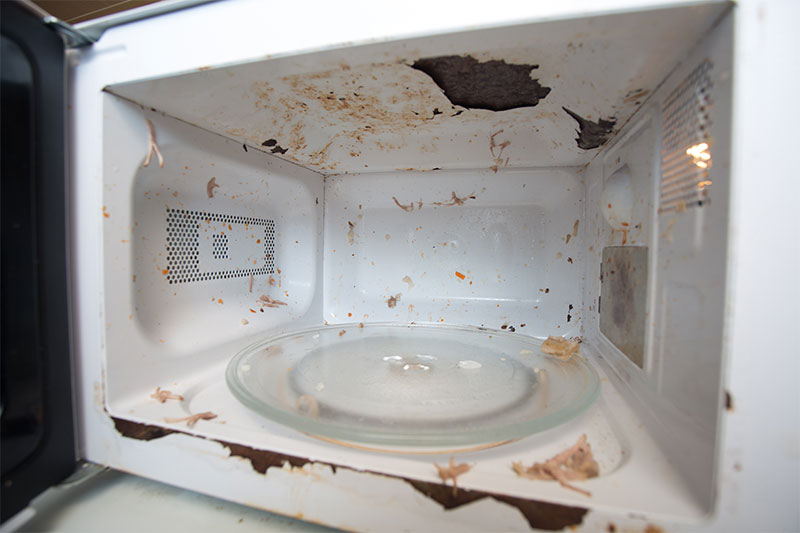Microwaves are commonly used to heat tomato soup, pasta sauce, rice packets, eggs, and other foods.
There is usually a mess, but you can also get hurt.
Food Is Microwaved, Why Does It Pop?
The outer membrane of food with a high moisture content will pop in the microwave because it traps the steam produced by the water molecules as they heat up and turn into vapor. It is also possible for moisture to build up on foods heated in packets, containers, or tightly covered bowls.
It’s that simple. This article will explain why food pops in the microwave and how to prevent it. You can also avoid accidents in the kitchen with a list of foods that might explode in the microwave.
When a microwave cooks food, the water molecules inside the food vibrate and create friction, which produces heat – this also makes steam as the molecules change from a liquid to a vapor. Steam expands as it turns into water.
Consequently, if a barrier surrounds the food, the steam will attempt to escape and cause an explosion because it takes up more space than when it is liquid. Foods like potatoes and eggs have a natural membrane that acts as a barrier that can be broken as steam tries to escape, causing the food to pop.
As the steam escapes, pressure builds up if the food is heated inside a packet or bowl tightly covered – such as by a lid or clingfilm. Rice packets produce some of the loudest and most forceful explosions due to their resilience and strength.
Foods That Pop More When Microwaved

In the absence of artificial barriers, such as packets and containers, why do some foods pop in the microwave while others do not? Foods with high moisture content are more likely to explode than foods with low moisture content. Since water produces steam when heated, an explosion is more likely when even a fragile membrane is present.
Foods with high fat and low moisture content tend not to explode because the fat molecules are not excited like water molecules.
For example, when you heat cooking oil in the pan, it just gets hot, but when you place food containing a lot of moisture – such as raw chicken – into the hot oil, it begins to spit because the water molecules inside the chicken heat up quickly.
In The Microwave, These Foods Are Likely To Explode
Foods with high moisture content and significant natural membranes are likely to explode in the microwave. Ideally, these foods should have their membranes pierced or be cooked/heated more gradually:
- Eggs with shells
- Potatoes
- Grapes
- Citrus Fruits
- Carrots that are not peeled
- Hot dogs
- Oatmeal
- Pasta sauce
- Sauce
- Ranch
Microwaves Can Cause Burns When Water Explodes
In a microwave, water can be boiled, but when disturbed, it can explode if it becomes superheated. Likewise, as coffee or another substance is added to undisturbed microwaved water, the water can rapidly convert to steam from being disturbed. Moving the cup can also trigger the process.
Tap water, on the other hand, is less likely to become superheated and erupt because it contains impurities that cause water to become disturbed during boiling, allowing the steam to escape as it rises.
Therefore, you should proceed with extreme caution when placing regular tap water in the microwave. Although it can result in an explosion, it won’t happen every time. Instead, water should be boiled in a kettle because it is safer.
Microwave Food Explosion Prevention
To prevent food from exploding in the microwave, you must create a way for the steam to escape by piercing the skin or natural membrane encasing the food; turning holes in any surrounding packaging and leaving the lid loose if the food is being heated in a container or bowl.
It’s a classic way to keep potato skins from exploding in microwaves if you use a fork to pierce them. Likewise, when you tear the top of a rice packet, the rice can heat up without the packaging exploding, and when you heat vegetables in a container with vents, steam will escape from the container.
To ensure that foods such as sauces, oatmeal, and soup are heated evenly throughout, stir the bottom layer of the food to escape any pockets of steam that have formed.
It’s also a good idea to heat the food slowly – say every 30 seconds – and stir when bubbles and steam appear.
Steam will also escape from the microwave when the door is opened. Therefore, it is possible to reduce the chances of the food popping by heating it gradually, such as using an oven – if applicable.
When food is heated in an open container, a ‘splatter cover’ is an excellent way to catch food particles. Still, the ventilation is typically better than covering the bowl with clingfilm and drilling holes, reducing the chance of an explosion.
Once your food has been heated, leave the door open and wipe down the inside of the microwave once it has cooled – doing so will remove moisture and food particles that could contribute to excessive steam production.


